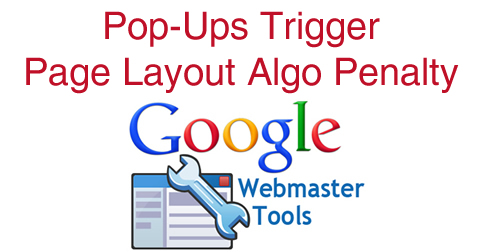 This will be good news for surfers but bad news for marketers employing this tactic – sites that display large popups as soon as a visitor loads a site could trigger the above the fold layout algorithm penalty.
This will be good news for surfers but bad news for marketers employing this tactic – sites that display large popups as soon as a visitor loads a site could trigger the above the fold layout algorithm penalty.
“When we look at the page layout, we look at what we crawl with Googlebot,” says John Mueller in a Google Webmaster Central office hours, “and since Googlebot doesn’t use any cookies, we will probably see that ad every time we visit. So that’s something we would take into account there.”
“But showing them a big banner from the beginning is something we’ll probably index or we’ll use for the page layout algorithm.”
John Mueller does give a great suggestion on how marketers should utilize popups so that they don’t affect the page layout algo. Because Googlebot doesn’t use cookies, he suggests not showing the popup until a visitor’s second visit to the website. Otherwise, Googlebot will see the popup every visit, which could impact the page layout algo on the site.
So bottom line, pop-ups won’t trigger the page layout algo penalty IF you set a cookie that will mean the pop-up is displayed only on subsequent visits.
Hat tip to Marie Haynes, of HIS Web Marketing.
Alan Bleiweiss says
Fascinating. I always suspected they might impact SEO for various reasons from page processing issues if the interstitial code is bloated or the image is too big and delays crawl, to whether it might be an issue where an interstitial blatantly delays users direct access to the content they came for.
I appreciate you covering this because it’s further reinforcement of those concerns.
Now… To get site owners to abandon them… And the automatically expanding full-width display ads. And the auto-play videos. And…
Jonah Stein says
It is amazing how time and time again Google tells us that we can do all the cloaking we want as long as we call it personalization.
Apparently, as soon as we start reading the cookie to trigger changes to the page (scroll, mouse over, mouse move) we can do anything we want and Googlebot will be non the wiser.
Somehow, this doesn’t really seem to be looking out for the best interests of users….
Toni Anicic says
That’s exactly how we solved the issue a month or so ago on one of our clients’ websites as well. Used a cookie to move it to the 3rd page view of the session. I found it to be a better solution for online stores anyway in terms of usability. Let the user see what you have before asking for his email.